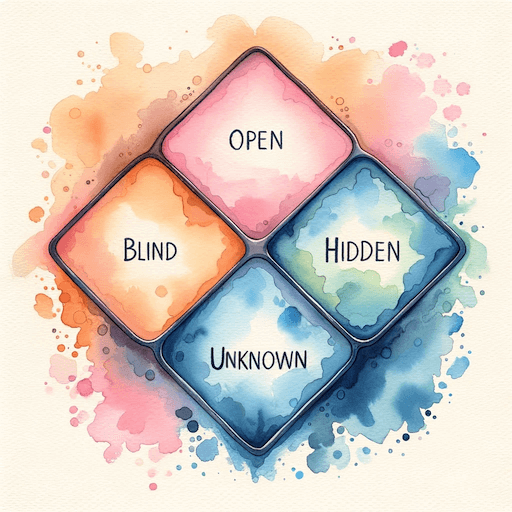Self-awareness
Johari Window

The realm of self-awareness is vast and often uncharted, yet understanding it is crucial for both personal and professional growth. Enter the Johari Window, a mental model designed to help you explore and expand your understanding of yourself and how others perceive you.
The Johari Window is a framework that divides personal awareness into four quadrants:
Open: Known to self and known to others.
Blind: Unknown to self but known to others.
Hidden: Known to self but unknown to others.
Unknown: Unknown to both self and others.
By considering each quadrant, individuals can gain a clearer perspective on their strengths, weaknesses, motivations, and unexplored potentials.
“He who knows others is wise; he who knows himself is enlightened.”
Origins of Johari Window
The Johari Window was developed in 1955 by psychologists Joseph Luft and Harry Ingham, during a research study at the University of California, Los Angeles. The name "Johari" is a combination of their first names (Jo + Hari).
Originally designed to support group dynamics in the workplace, the model has since been widely adopted in various fields such as personal development, therapy, and organizational behavior.
Limitations
Like all models, the Johari Window isn't without its limitations:
Over-simplification: Not all aspects of self-awareness can be neatly fitted into the four quadrants. Human emotions and perceptions are complex and multi-dimensional.
Dynamic Nature: The information in each quadrant isn't static. As people grow and evolve, what's known and unknown can shift between quadrants.
Dependence on Honesty: The efficacy of the Johari Window is largely based on honest feedback from others and introspection from the individual. This can be skewed by biases, reluctance to share, or misunderstandings.
Examples
Open Quadrant: An employee is punctual. Both the employee and their colleagues are aware of this trait.
Blind Quadrant: A manager might be unaware that they tend to interrupt team members during meetings, but the team is acutely aware of this behavior.
Hidden Quadrant: A team member might have leadership skills they've never showcased at work because they're unsure of how their efforts would be perceived.
Unknown Quadrant: A person might have latent talents or traumas they haven't yet discovered, and neither have their peers.
Implementation
Self-reflection: Start by listing qualities, traits, or behaviors you believe you possess in the Open and Hidden quadrants.
Seek Feedback: Ask close peers, friends, or family members for honest feedback about their perception of you. This will help you identify elements in the Blind quadrant.
Encourage Open Communication: Create a safe space where people feel comfortable sharing feedback. This will make the Blind quadrant more transparent.
Personal Development: Engage in activities outside your comfort zone. This might reveal aspects of the Unknown quadrant.
Revisit Regularly: Make it a habit to revisit your Johari Window periodically to note changes and evolutions.
The Johari Window, while not exhaustive, offers a structured way to introspect and gather feedback for better self-awareness. By understanding ourselves and how we're perceived, we can make informed decisions, improve relationships, and foster personal growth.